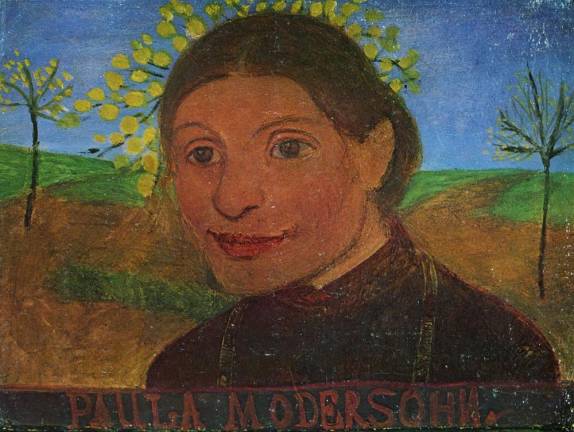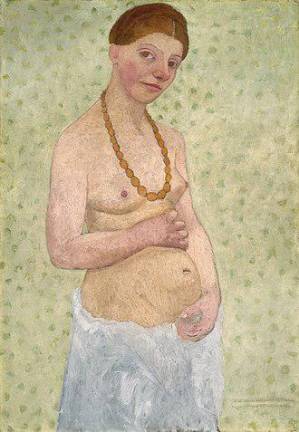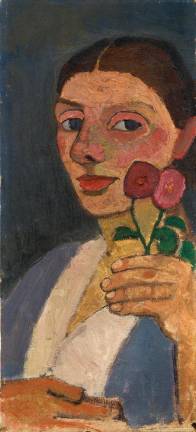UES Gallery Presents First-Ever US Show of Famed German Artist Paula Modersohn-Becker
The Neue Galerie on upper Fifth Ave. near E. 86th St. presents the first-ever U.S. retrospective of the German expressionist painter in a show entitled “Ich Bin Ich / I Am Me.” But hurry, the show is only on through Sept. 9.
Paula Modersohn-Becker seems to have been of two minds on many things. In her life and work dualities abound – domesticity/career, big city/countryside, belonging/individuality. But she was undivided in her loyalty; it was always to art. In her short peripatetic life (she lived only to age 31) Modersohn-Becker lived in Germany, England and France; had an on-off marriage; was a less than obedient daughter; and though she loved and wanted children, she didn’t want the trappings of wifely motherhood. All she really wanted was to be an artist.
One step into the Neue Galerie’s exhibition on E. 86th St–the first retrospective of her work in the United States–will convince you that she succeeded. spectacularly.
Like all artists, Modersohn-Becker’s life informed her vision, and an understanding of her path brings her work into sharper focus. But, knowing nothing of her history, if you look directly at the portraits, still lifes and landscapes on display, you’ll see the hallmarks of great modern art at the beginning of the 20th century. Flattened planes of color. Check. Thick, impasto brushwork and dark outlines. Check. Abandonment of the rules of perspective, realism that veers sharply from precise reproduction, emotional states evoked through expressive forms and shapes. Check, check, and check.
And yet, while the experimentations that shocked and shook the art world in 1905, 1906, and 1907 are all present in Modersohn-Becker‘s work, here, they have a different sensibility.
Despite similar elements in Picasso, Matisse, Modigliani or Cezanne, Modersohn-Becker‘s were distinctly a woman’s work based on a woman’s world. Look for portraits of women and children, but don’t expect saccharine or saints. Tilted tables of fruit are decked in modernity, but look nourishing. Perhaps most importantly, nude female figures are neither fetching nor coy. They are simply women being women, and Modersohn-Becker has captured that sense of being, including in a beautiful semi-nude self portrait, probably the first in the history of art –a portrait of the artist as a pregnant woman.
”Self-Portrait on Her Sixth Wedding Anniversary,” shows a gently smiling Modersohn-Becker with a swath of fabric wrapping her lower torso, looking straight at the viewer. She cradles her swollen belly. But there’s a secret behind the famous pose. “It is an imaginary pregnancy at this point. This is painted in May, 1906, after she’s left her husband and she’s arrived in Paris. It is an extraordinarily public statement of a private, intimate sense of herself,” curator Jill Lloyd explains in the exhibition preview, adding “She really wants a child. We know this from her correspondence.”
Lloyd finds symbols of fecundity throughout Modersohn-Becker‘s paintings, including burstingly ripe fruits and vegetables, paintings of children and infants, as well as nursing mothers. “I think it’s also the idea that women have this extraordinary, unique dual creativity. We can both be mothers and we can be creative artists, and it’s a symbol of that.”
Paula Modersohn-Becker was born in 1876 in Bremen, Germany to middle-class parents who valued culture, but also assumed that women would need husbands. At age 16, she was sent to England to learn valuable household skills–like butter churning–from her aunt, although her English uncle took pity on her and sent her for art lessons.
When she returned to Germany, her parents arranged for her to study to be a teacher, but again, she managed to fit in art classes. When those ended, it was off to live in an artists’ colony, Worpswede, where she befriended the sculptor Clara Westhoff, the poet Rainer Maria Rilke, and the painter Otto Modersohn, whom she married. But before long, art called, and she answered by going to Paris, where she studied, painted and attended exhibitions of artists like Cezanne and Picasso.
By 1907 lack of funds drove her back to Germany and her husband, despite her entreaties for him to join her in Paris. But, by November of that year, she had settled in, and was pregnant with a daughter. One of the highlights of the exhibition is her final self portrait, owned by jointly by The Neue Galerie and the Museum of Modern Art. In this, she is actually pregnant, smiling, dressed in a blue robe and holding two flowers of the same size out towards the viewer.
One blossom is bright and pink; the other is darkened with shadow. Does one represent her nascent career, now overshadowed by new life? Does the soft pink one seem as exciting to her? We’ll never know. Shortly after the painting was completed, she gave birth to her daughter. The doctors ordered complete rest for the new mother. After 18 days in bed, Modersohn-Becker got up, eager to begin her new journey. She died immediately of a postnatal embolism. Her final words were “A pity.”
There’s never been a better time in New York to get to know Modersohn-Becker. Gallery after gallery presents paintings and drawings that speak equally of a loving eye and a confident hand from a woman who knew she could make it.
In that final self-portrait from 1907, after running out of funds in Paris, returning to Germany, rejoining her husband, she didn’t cede one inch of her journey as an artist (dualistic, as ever). Just look at those brushstrokes across her forehead and cheeks. Gutsy, bold, and painterly. Here, she declares, unambiguously, “I am a woman. I am a painter,” but ultimately, as the exhibition title quotes her, “I am me.”
The Neue Galerie, 1048 Fifth Avenue (at 86th Street)
Monday, 11 a.m. to 6 p.m., Wednesday–Sunday, 11 a.m. to 6 p.m. (Closed Tuesday)
(212) 994-9493, www.neuegalerie.org
Perhaps most importantly, nude female figures are neither fetching nor coy. They are simply women being women...



